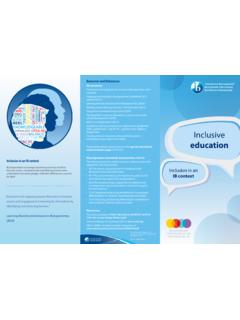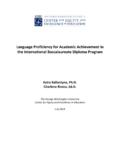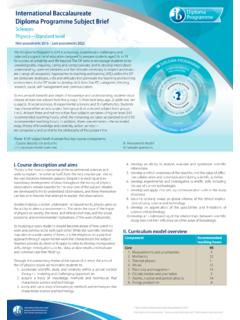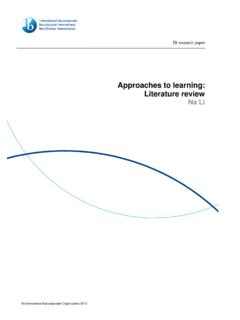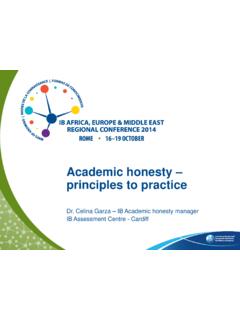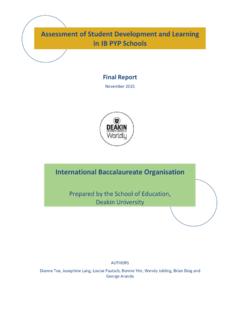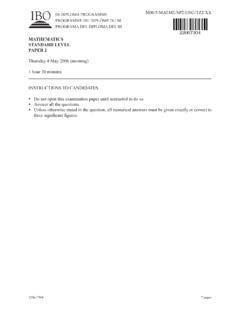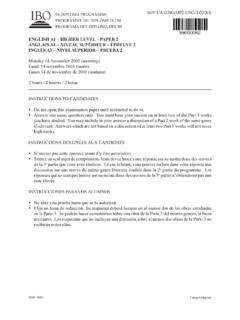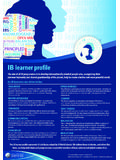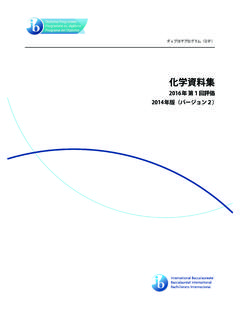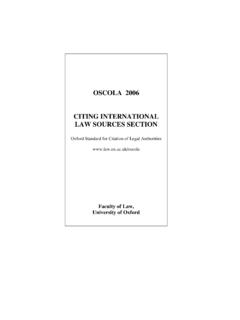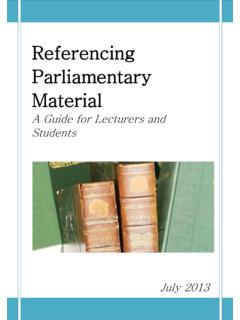Transcription of Guide for IB students applying to Canadian institutions
1 Guide for IB students applying to Canadian institutionsThis Guide provides a brief introduction to the Canadian higher education system and its application process, as well as information specifically relevant to IB students applying to Canadian institutions from outside of Canadian contextThroughout Canada s 10 provinces and 3 territories, there are 98 higher education institutions . Rather than having a centralized federal higher education system, each prov-ince and territory has its own distinct education system. Public and privateThere are public and private institutions throughout Canada, however the majority of universities are public institutions . Most public institutions have province-wide admissions requirements, whereas private institutions do not need to follow provincial or territorial admissions requirements.
2 Both public and private institutions might offer one or several types of degrees and programmes. Public institutions receive most of their funding from the provincial, territorial and/or federal government, making them generally less expensive to attend than private institutions . Because of the high number of facul-ty research grants, public institutions tend to have large departments offering a variety of degrees. Private institutions receive the majority or entirety of their funding from alumni donations, faculty research grants and tuition fees. This makes them more expen-sive to attend, but allows for more resources available to s degreesBachelor s degrees can be obtained at many higher education institutions and are completed in three or four years of full-time study, depending on the province and whether the programme is general or specialized.
3 Some students might complete an honours bachelor s degree, which indicates a higher level of concentration within the subject as well as a higher standard of academic achieve-ment. Liberal arts educationLiberal arts programs offer courses in the arts, humanities, languages, mathematics and social and physical sciences, and they aim to cultivate general intellectual capacities. When obtaining a bachelor s degree in the liberal arts, students will specialize in their chosen programme (also known as a major or subject), but will also receive gener-alized education across the spectrum of education and community collegesCanada also has professional, technical or vocational institutions , as well as community colleges (often referred to as just "colleges"), which tend to provide more special-ized courses of study.
4 Colleges are government-regulated institutions offering various degrees, including pre-professional certificates, two-year associate s degrees and, in some cases, four-year specialized bachelor s degrees. There are more than 150 colleges in Canada, with approximately 900,000 full-time and million part-time students . With this option, students can graduate from college and be prepared for a career or transfer to a four-year institution to get a bachelor s degree. Colleges tend to be less expensive than other types of institutions . As college faculty gener-ally do not conduct research, there is a stronger emphasis on teaching, but there are fewer research opportunities for students . AccreditationCanada does not have an accreditation system that assesses the quality of higher education institutions , although some provinces have charters or legislation that serves as a substitute.
5 Without a national system, howev-er, you should verify that your degree is recognized in the specific province to which you are applying . University rankingsThere is no official ranking system for higher education institutions in Canada, but there are independent bod-ies that conduct subjective rankings annually. Canadian universities are commonly ranked among the highest globally. For example, the QS World University Rankings 2014/15 listed five Canadian universities among the top 100 universities in the to Canadian universitiesWho to contactThere is no centralized application procedure for Canadi-an institutions ; students apply to each institution indi-vidually. While some provinces have general admissions requirements for their public institutions , each institution will outline the requirements on its website, alongside any additional requirements for that specific school.
6 The exception is the province of Ontario, which uses a standardized application system to the public institutions in that province; the Ontario Universities Application Centre allows students , including international students , to submit one application that is sent to their chosen institutions in an area of studyWhile many institutions allow students to study a variety of subjects, most application processes require students to choose a programme or area of study that is intended to be their focus throughout their education. Specific programmes or faculties within a university might have their own admissions requirements, which may include additional application materials or specific grade or IB score requirements. Because of this, it is important for students to focus on their academic performance and search for institutions that match their interests and level of academic applicationThere is no national university entrance exam, and each institution has its own admissions standards and evalua-tion process.
7 Most applications can be completed online, and most institutions require biographical information, education background (including transcripts, IB predicted grades, and IB final grades when available) and intend-ed area of study. Some universities might ask for letters of recommendation, personal essays or test scores, so students should find out what an application will require well in advance of the application deadline. Timeline It is important to check the application deadline for each institution, as deadlines may vary, but many are in December or January. Some institutions have a rolling admissions process, which means that there might not be a strict application deadline. Decisions from a univer-sity might be sent out as early as three weeks after the application is received, or they may take several months.
8 Some institutions offer conditional acceptances, and when final grades and/or IB scores are sent, the offer is either rescinded or made for IB students Many Canadian higher education institutions offer benefits to IB students . Benefits are determined by each institution individually, but might include credit for certain IB scores, scholarships or tuition assistance. Some universities allow IB students to enter their institution as second-year students , meaning the undergraduate edu-cation will be three years instead of four. students taking Diploma Programme (DP) courses but not the full diploma might be able to receive credit from institutions for individual courses, but policy is also determined by each institution, and sometimes each individual programme or faculty within the institution.
9 Most institutions indicate their IB recognition policy on their gradesIt is important to note that the admissions cycle in Canada takes place before IB students even sit exams. Thus, most admissions decisions are based in part on the student s anticipated grades submitted by the school. If a student s final IB scores are significantly below the antic-ipated grades submitted by the school, it is possible for the university to withdraw its offer. As such, it is vital that teachers and schools report students anticipated grades as accurately as possible. This is not only important for students futures, but if a school consistently inflates anticipated grades, it may tarnish that school s reputation with the university. Who sends transcripts to Canada?In 2014, 3,440 IB students from schools in 115 countries outside of Canada sent 4,832 transcripts to 102 Canadian institutions , an average of transcripts per student.
10 This average suggests that more than half of students only send transcripts to a single institution. Where do IB students send transcripts?The 10 institutions that received the largest number of IB transcripts in 2014 account for nearly 80% of all tran-scripts sent to Canada1. All 10 are public institutions , and 9 of the 10 are ranked among the top 500 by QS World University Ranking2. Three are ranked in the top 50. Most common source of transcripts coming into Canada1 For this analysis we combined all campuses and faculties under a single institution. 2 3 These institutions are listed in alphabetical order, and inclusion here does not necessarily indicate that these institutions have the most generous or appropriate offerings for IB possible, language taken directly from the university website.
